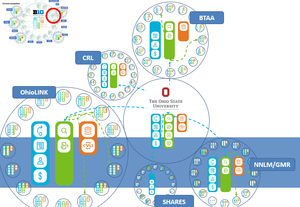The Google digitization of books appears to have caught the public imagination. Recent weeks have seen high profile articles in The Economist [subscription required] and The New Yorker as well as several newspaper pieces (see the links and response on this OUP blog entry for example).
Google Book Search is a major endeavor, and Google have brought an impressive service online with impressive speed. The media stories tend to have different hooks. Inevitably, some pivot on a description of confrontation between publishers and Google; others discuss it in the context of a general digital turn, or the future of the book.
In some of the more reflective discussion I am interested to see a particular strand emerge. And that is the acknowledgement that the book, in its material form, is itself a designed and evolved technology, rather than a permanent or unchanging feature of our experience. Simply, this may involve talking about the ‘technology’ of the book. Or it may take more elaborate form.
Of course, the material book – its technology, circulation, reception, institutions – is a strong if diffuse field of enquiry. However, now, it is as if the change in perspective brought about by the digital turn has made the technology of the book more popularly visible and discussed just as that, as a particular technology which can be compared to others. And, having become used to talking about the impact on practice and potential of new technologies, we may now use that language to also describe earlier forms and their impact.
However, now, it is as if the change in perspective brought about by the digital turn has made the technology of the book more popularly visible and discussed just as that, as a particular technology which can be compared to others.
Seeing it in this way reinforces an awareness that the book itself, the codex, represents particular technological choices which in turn have influenced how we create and engage with the intellectual and cultural record, and in turn with broader experience and intellectual development.
This for example, comes from a recent discussion of copyright and book digitization by the writer John Lanchester. Incidentally, it is encouraging to see a piece which is so appreciative of a library and library staff. He talks about the technology of the library and of the book.
The buildings of the Bodleian are so old, and in their golden Cotswold stone so beautiful, that it is easy not to see how insistently modern an institution the library has tended to be. The very beginnings of the collection, in Duke Humfrey’s Library above the divinity school, showed how Thomas Bodley’s own bibliographic vision had to react to a technological shift. The new collection was built to accommodate the transition from the long-established, tried-and-tested technology of unique handwritten texts to the hot new mass-produced technology of the printed codex: in other words, the book. Duke Humfrey’s Library has high stacks of shelves, which the reader can’t directly access: the world’s first closed stacks. These were designed to accommodate the increasing number of books too small to chain securely to open shelves, and were an important repository of copies from the Stationers’ Company. Issues of copyright and of access to information were thus built into the institutional DNA from the start. The very layout of the buildings, with teaching “schools” tucked in the corners of the quadrangle, reflected new ideas about the connection between the library as a repository of information and the university as a place of instruction. [John Lanchester: Who owns what in the digital age? | News | Guardian Unlimited Books]
And after a marvellous description of the technology of delivery from the stacks, he concludes that “it is impossible not to miss the point: a library is a machine for storing and retrieving information”. Later in the piece he quotes Richard Ovenden, of the Bodleain:
“The codex was a technological leap. It works very well, has done so for 2,000 years, and still does so – people still find it very easy to use. What digitisation does is to highlight that.”
Here is another example, following nicely from the last comment. The origins of the codex were discussed recently in The New York Review of Books by Eamon Duffy, in a review of two books on the role of the book in early church history [available to subscribers or for purchase]. Here is his opening paragraph:
These two books are built on a single perception. Early Christianity was more than a new religion: it brought with it a revolutionary shift in the information technology of the ancient world. That shift was to have implications for the cultural history of the world over the next rwo millennia at least as momentous as the invention of the Internet seems likely to have for the future. Like Judaism before it and Islam after it, Christianity is often described as “a religion of the Book.” The phrase asserts both an abstraction – the centrality of authoritative sacred texts and their interpretation within the three Abrahamic religions – and also a simple concrete fact – the importance of a material object, the book, in the history and practice of all three traditions.
Note how he talks about the book as a shift in information technology, and makes the comparison with the impact of the Internet explicit. In a fascinating piece, he goes on to discuss the practical and political reasons why the codex was favored over the scroll in early church writing. In the context of my point here, consider his later references to technology.
Why should the new religion have adopted this down-market and unfashionable book technology? … However that may be, until recently surprisingly little has been made of this momentous foundational shift to a new book technology.
I think that this terminology is symptomatic of a positive trend, a recognition that the book itself, while central, influential and marvelously adapted to various uses, is not some natural given. It is another sign that we are moving beyond the reductive opposition between the book and the digital turn.




